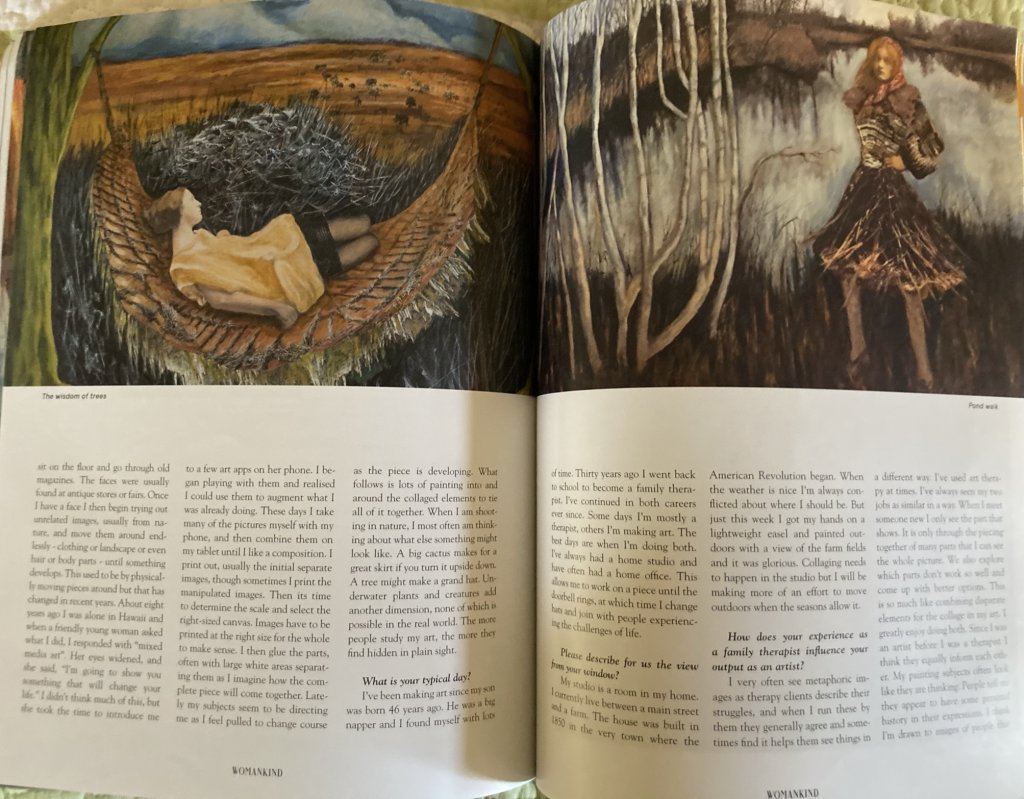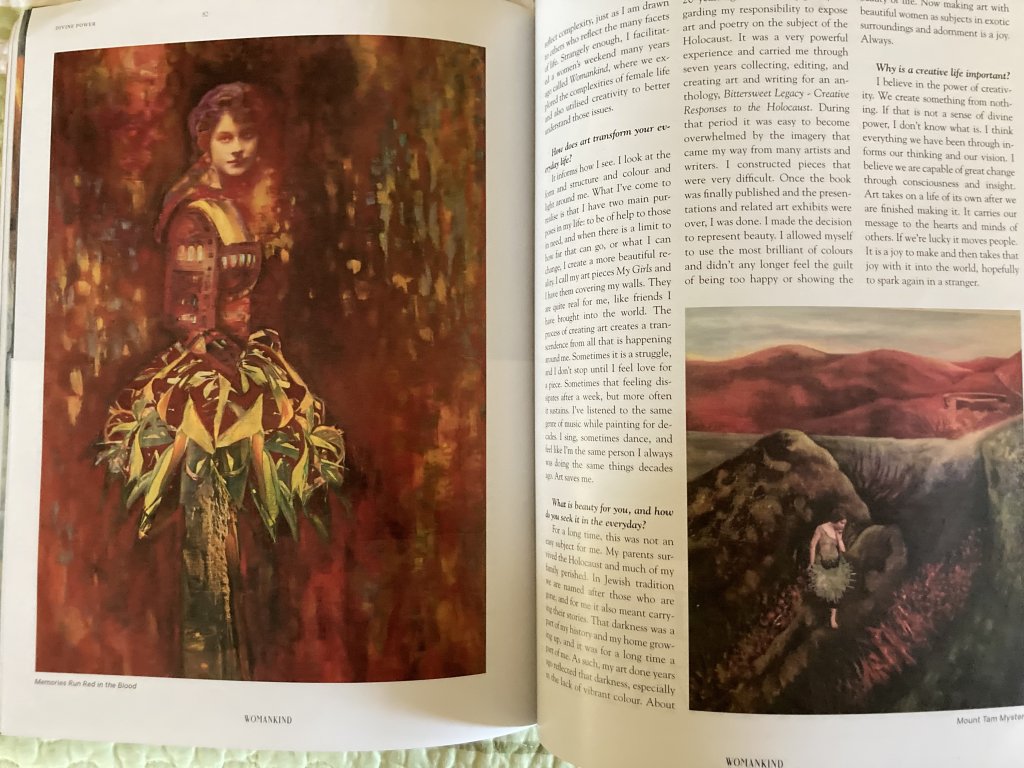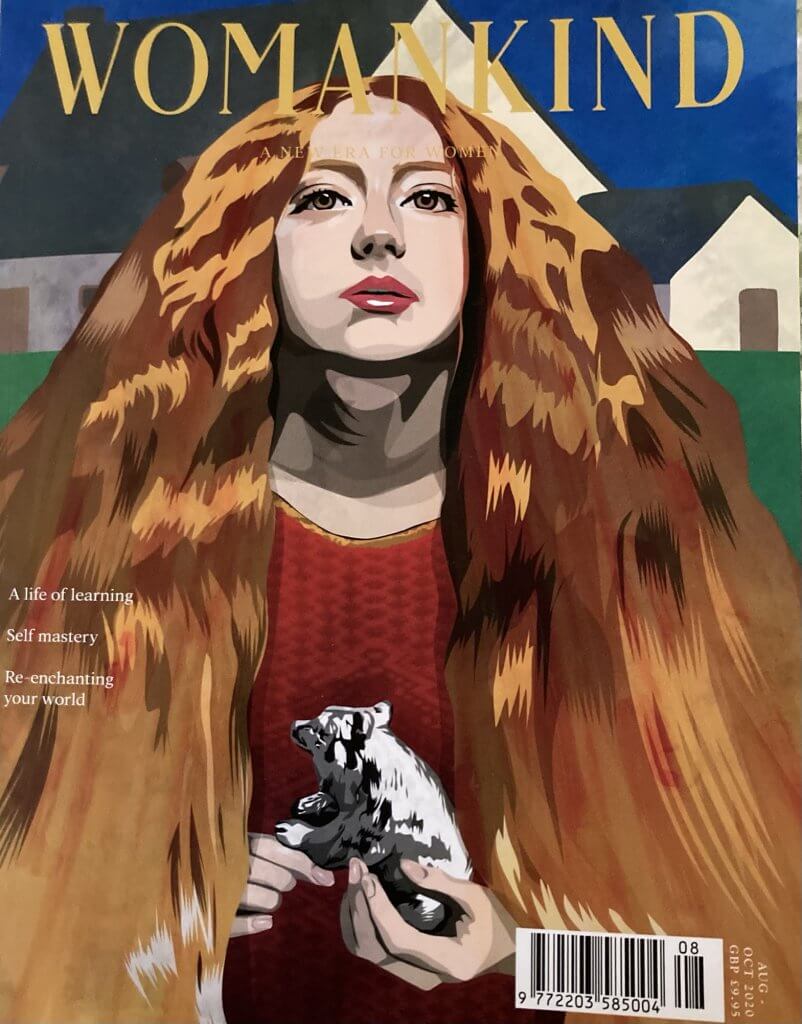(See Images below)
- Background as an artist
I distinctly remember being given my first drawing pad and pencils at about 12 years old, but I am told I was always drawing as a younger child. I spent high school sketching fashions when I should have been paying attention. I thought I’d like to be a fashion illustrator, but when I didn’t get into the one program to which I’d applied I decided I probably wasn’t very good and hung up my pencil. At age 24 with two children, I found myself in a consciousness raising group (they were great) and when I complained that at my ripe old age I’d given up what I really loved doing, the stranger to my right set me straight. She suggested I stop complaining about it and just do it. I’d thought it was too late (at 24) but was then inspired to start again. I think often teachers are critical and discourage young people who then walk away from their dreams
I started taking basic art classes locally and in New York at art schools and attended life-drawing studios weekly. I was quickly diverted from fashion sketching and began experimenting with various media. Although I enjoyed honing necessary skills in drawing and painting, I soon came upon the idea of combining elements along with paint and I’ve never looked back. That was over 40 years ago. I’d have to say that most of my technique is self-taught. Although the way I go about planning the imagery has changed, I’ve always painted women. When people ask why, and they still do, I say it’s probably because I can relate to the complex emotions as well as the intrinsic beauty in the female form. I enjoy representing women of many cultures due to the sense of mystery, and the adornment, which is so rich in color and pattern.
2. My process
People are always asking me about my process. It is one that is hard to capture in words. I usually start with a face. I use images of women who lived over 100 years ago and then delight in giving them a new life. Some were models or actresses who had tragic private lives (I generally only discover this after researching them when the piece is completed) and I love the idea that I’ve freed them.
In the days before digital apps I would sit on the floor and go through old magazines. The faces were usually found at antique stores or fairs. Once I have a face I then begin trying out unrelated images, usually from Nature, and move them around endlessly until something develops-clothing or landscape or even hair or body parts. This used to be by physically moving pieces around but that has mostly changed in recent years. About 8 years ago I was alone in Hawaii and when a friendly young woman asked what I did, I responded with “mixed media art”. Her eyes widened and she said, “I’m going to show you something that will change your life.” I didn’t think much of this, but she took the time to introduce me to a few art apps on her phone. I began playing with them and realized I could use them to augment what I was already doing. (I’m realizing as I write this that women who were strangers to me were pivotal in affecting my life as an artist.)
These days I take many of the pictures myself with my iPhone, and then combine them on my IPad until I like a composition. I print out, usually the initial separate images, though sometimes I print the manipulated images. Then its time to determine the scale and select the right size canvas. Images have to be printed at the right size for the whole to make sense.
I then glue the parts, often with large white areas separating them as I imagine how the complete piece will come together. Lately my subjects seem to be directing me as I feel pulled to change course as the piece is developing. What follow is lots of painting into and around the collaged elements to tie all of it together.
When I am shooting in Nature, I most often am thinking about what else something might look like. A big cactus makes for a great skirt if you turn it upside down. A tree might make a grand hat. Underwater plants and creatures add another dimension, none of which is possible in the real world. The more people study my art, the more they find hidden in plain sight.
3. Have I always been a mixed media artist?
I think I covered most of this in #1
4. What is my typical day?
I’ve been making art since my son was born 46 years ago. He was a big napper and I found myself with lots of time. Thirty years ago I went back to school to become a Family Therapist. I’ve continued in both careers ever since. Some days I’m mostly a therapist, others I’m making art. The best days are when I’m doing both. I’ve always had a home studio and have often had a home office. This allows me to work on a piece until the doorbell rings, at which time I change hats and join with people experiencing the challenges of life
5. The view from my window
My studio is a room in my home. I currently live between a main street and a farm. The house was built in 1850 in the very town where the American Revolution began. When the weather is nice I’m always conflicted about where I should be. But just this week I got my hands on a lightweight easel and painted outdoors with a view of the farm fields and it was glorious. Collaging needs to happen in the studio but I will be making more of an effort to move outdoors when the seasons allow it.
6.Influence of being a psychotherapist on my art
I very often see metaphoric images as therapy clients describe their struggles, and when I run these by them they generally of agree and sometimes find it helps them see things in a different way. I’ve used art therapy at times. I’ve always seen my two jobs as similar in a way. When I meet someone new I only see the part that shows. It is only through the piecing together of many parts that I can see the whole picture. We also explore which parts don’t work so well and come up with better options. This is so much like combining disparate elements for the collage in my art. I greatly enjoy doing both. Since I was an artist before I was a therapist I think they equally inform each other. My painting subjects often look like they are thinking. People tell me they appear to have some personal history in their expressions. I think I’m drawn to images of people that reflect complexity just as I am drawn to others who reflect the many facets of life. Strangely enough, I facilitated a women’s weekend many years ago called Womankind, where we explored the complexities of female life and also utilized creativity to better understand those issues.
7. What is beauty to me and why is it an important part of life.
For a long time this was not an easy subject for me. My parents survived the Holocaust and much of my family perished. In Jewish tradition we are named after those who are gone, and for me it also meant carrying their stories. That darkness was a part of my history and my home growing up, and it was for a long time a part of me. As such, my art done years ago reflected that darkness, especially in the lack of vibrant color.
About 20 years ago I had an epiphany regarding my responsibility to expose art and poetry on the subject of the Holocaust. It was a very powerful experience and carried me through 7 years collecting, editing and creating art and writing for an anthology, Bittersweet Legacy – Creative Responses to the Holocaust. During that period it was easy to become overwhelmed by the imagery that came my way from many artists and writers. I constructed pieces that were very difficult. Once the book was finally published and the presentations and related art exhibits were over, I was done. I made the decision to represent beauty. I allowed myself to use the most brilliant of colors and didn’t any longer feel the guilt of being too happy or showing the beauty of life. Now making art with beautiful women as subjects in exotic surroundings and adornment is a joy. Always.
8. How does being an artist transform me every day?
It informs how I see. I look at the form and structure and color and light around me. What I’ve come to realize is that I have two main purposes in my life. To be of help to those in need, and when there is a limit to how far that can go, I or what I can change, I create a more beautiful reality. I call my art pieces My Girls and I have them covering my walls. They are quite real for me, like friends I have brought into the world. The process of creating art creates a transcendence from all that is happening around me. Sometimes it is a struggle, and I don’t stop until I feel love for a piece. Sometimes that feeling dissipates after a week, but more often it sustains. I’ve listened to the same genre of music while painting for decades. I sing, sometimes dance, and feel like I’m the same person I always was doing the same things decades ago. Art saves me.
9. Additional thoughts
I believe in the power of creativity. We create something from nothing. If that is not a sense of divine power I don’t know what is. I think everything we have been through informs our thinking and our vision. I believe we are capable of great change through consciousness and insight. Art takes on a life of its own after we are finished making it. It carries out message to the hearts and minds of others. If we’re lucky it moves people. It is a joy to make and then takes that joy with it into the world, hopefully to spark again in a stranger.




